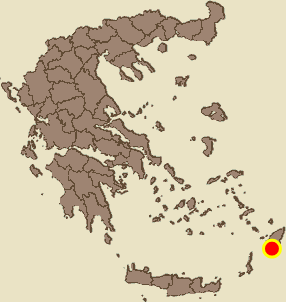Kattavia, Rhodes, Dodecanese,South Aegean
Paliokastro of Kattavia
| Location: |
| On a hill at southern Rhodes island, 2km NE of the village Kattavia |
| Region > Prefecture: |  |
| South Aegean Dodecanese | |
| Municipality > Town: | |
| City of Rhodes • Kattavia | |
| Altitude: | |
|
Elevation ≈ 259 m (Relative Height≈160 m) |
| Time of Construction | Origin | |
| unknown | BYZANTINE |
|
| Castle Type | Condition | |
| Castle |
In Ruins
|
Ruins of a Byzantine castle and a fortified settlement not far away from the village of Kattavia.
Castle Description
Text: Dr. Michael Losse – Singen (Hohentwiel), Germany (27.11.2021)General Description
Kattaviá, the southernmost village on Rhódos, is located in a plain surrounded by mountains and hills in a fertile region that was heavily populated during the Byzantine period, as evidenced by several churches. Comparatively large is the number of fortifications around Kattaviá mentioned in the literature, but many of the researchers did not perceive the ruins of the Kástro within the village (see Kastrologos: Castle of Kattavia).
Giuseppe Gerola (1914) listed, in addition to Piliokastro (“Paleókastro”) and the castle inside the village of Kattavia the nearby “resti di fortificazioni medioevali" on the hill called Stavrós, several watchtowers (“Dhermatàs”, meaning Jermata [see Kastrologos: Watchtower at Cape Jermata]; “Mávru” meaning Mavros Kavos) and the tower on Prasonisi peninsula (see Kastrologos: Watchtower at Prasonisi).
Almost 2 km east-northeast of Kattavia rises the Piliokastro (occasionally also called Palaiokastro), a striking high mountain (259 m), which visually “dominates” the eastern access to the plain of Kattavia. The mountain is crowned by a Byzantine castle of the same name. The flattened limestone breaking into steps gives it its distinctive shape.
Within the outer bailey or fortified settlement below the castle with remains of the approximately 0.92 m thick, double-shelled defensive wall, a large, remarkable cistern has been preserved almost 100 m from the inner castle: The deepened two-nave, formerly covered with barrel vaults, 10.2 m long building divides an intermediate wall with three arch openings into two rooms (2.9 and 2.2m wide and over 4m high; dimensions according to Heslop 2009, pp. 71-72). The staircase leading to the cistern in the southeast corner and individual surfaces of the interior plaster have been preserved.
The main or inner castle occupies the striking summit of the mountain. Its mortarless enceinte, which partly runs over bricked rock crevices, has an approximately oval layout. It is 1.04 to 1.40 m thick, made of quarry stone with compensating joints and shows no brick developments (such are only found in buildings inside and on the "tower"), but in some parts "half" opus spicatum. On the northeast side, there could have existed a (late medieval?) barbican.
The interior of the castle is modern; according to some elderly inhabitants of Kattavia, it was built by the Italians during the 2nd World War. Michael Heslop (2009, ibid.) interpreted masonry inside the castle as a substructure of a former tower.
In some areas of the castle there are remains of Italian fortifications and trenches from the 2nd World War.
The castle hill offers good visual connections to several Byzantine fortifications in the south of the island of Rhodes (including the Vigla near Kattavia, which was probably the location of a castle, and the fortification on Mt. Vouni near Mesanagros) as well as parts of the east coast. Also Mt. Akramitis can be seen from here.
Access
There is no path to the castle on the summit, but this is easy to reach on sight (through bushes). First follow one of the dirt roads on the southwest or southeast side of the mountain and then continue on sight.
Note: Please be considerate – sometimes owls breed in the large cistern!
History of the castle
It is said that the castle of Kattavia already existed before the time of the rule of the Order of the Knights Hospitallers (cf. Stephen C. Spiteri: Fortresses of the Knights. Ħamrun, Malta, 2001, p. 150), but it seems to be a confusion with the Piliokastro with its fortified settlement, which most probably was the older castle of Kattavia, built under Byzantine rule.
While comparatively little pottery remains were found within the castle, there are larger quantities in its surroundings and especially in the rinse gutts at the end of the dirt-road. Single fragments of classical ceramics (black) were observed by us.
The impressively situated castle still needs extensive historical and archaeological research.
Other Info
SourcesGerola, Giuseppe: I monumenti medioevali delle 13 Sporadi. In: Annuario della Scuola Archeologica di Atene e delle Missioni Italiane in Oriente, Vol. I, 1914, pp. 319-356.
Heslop, Michael: The Search for the Byzantine Defensive System in Southern Rhodes. In: Βυζαντίνος Δόμος 16 (2007-2008) [published in June 2009], pp. 69-81.
Losse, Michael: Die Burgen und Festungen des Johanniter-Ritterordens auf Rhódos und in der Ägäis (Griechenland) 1307-1522. (Publisher: Nünnerich-Asmus Verlag) Mainz 2017.
Losse, Michael: „Erimókastra“ und „Ritterburgen in dem edlen Style des fünfzehnten Jahrhunderts“ – Neue Erkenntnisse zu Burgen und Wehrbauten auf Griechenlands „Ritterinsel“ Rhódos. In: Burgenforschung – Europäisches Correspondenzblatt für interdisziplinäre Castellologie (will be released in Spring 2022).
| First entry in Kastrologos: | December 2015 | Last update of info and text: | November 2021 | Last addition of photo/video: | November 2021 |
Sources
- Website ΟΔΥΣΣΕΥΣ -Greek Ministry of Culture - Κάστρο Κατταβιάς
- Photos (2-6 of 2007 – 1,7 of 2014) and article (Nov 2021) by Dr. Michael Losse
|
|
| Access |
|---|
| Entrance: |
| Free access |



